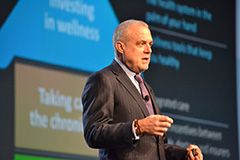Article
HIMSS keynote: Aetna’s Bertolini calls for transformative healthcare change
During his keynote address at the 2014 Healthcare Information and Management Systems Society conference, Aetna’s CEO Mark T. Bertolini calls for transformative healthcare change focused on wellness, aligned incentives, and a crackdown on wasteful spending.

Aetna Chairman, President and CEO Mark T. Bertolini (Photo courtesy of Aetna)“We don’t need to put 30 million new people in the same maze,” says Aetna’s chairman, president, and chief executive officer Mark T. Bertolini. “We need to first figure out (our healthcare system) and improve it.”
Bertolini delivered a message about the importance of healthcare reform to thousands of attendees during a keynote presentation February 24, 2014, to kick off the 2014 Health Information Management Systems Society (HIMSS) annual conference in Orlando, Florida.
In a year that saw many key provisions of the Affordable Care Act take effect, Bertolini called for transformative change of a system that is literally “breaking the bank” of the U.S. economy.
The healthcare system, Bertolini says, was created in 1945, and it no longer functions effectively. Year after year, healthcare costs have been climbing, and it’s estimated the system now creates nearly $800 billion in wasteful spending on unnecessary services, inflated prices, inefficient care delivery, and administrative costs.
At the same time, the prevalence and costs associated with chronic disease conditions in this country are also increasing. Healthcare premiums are growing at rates four times faster than inflation. These negative trends will require structural change. But “we cannot solve our problems today with the same thinking that we used to create them,” Bertolini adds.
Patients will drive some of this change, especially as they are asked to finance more of their healthcare costs. Currently, employees are paying 41% of healthcare costs, but estimates are that number may grow to 50% in the future. “If we reach that point, you will have a very different customer sitting before you.” It will be a patient very focused on recommendations and the economic implications, he says.
The United States needs to develop a more integrated model of healthcare delivery that leverages the strengths of care teams, empowers patients, and builds more collaboration between payers and providers. According to Bertolini, the stakes are high when it comes to transforming healthcare in the United States. Consider this, he says: if the healthcare system worked to eliminate all of its wasteful spending over the next 10 years, it would wipe out nearly 50% of U.S. national debt.
Here are some of the keys Bertolini believes will help transform healthcare:
- Enable customers to take control of their healthcare through connected, digital tools.
- Move “carrots away from the highest-cost centers” such as hospitals to reward providers delivering high-quality care for far less.
- Align payer incentives with providers, and partner to deliver a “win-win” proposition.
- Patients need to see healthcare service as an investment in their health and financial security.
- Invest in wellness. While it will likely be a 25- to 30-year experiment, it is necessary to see if the United States can improve health outcomes and reduce the incidence of disease.
- Better manage chronic disease. The number of Americans suffering from chronic disease conditions is almost as staggering as the costs associated with caring for these health problems. “The chronically sick deserve focus factories that deliver better care,” Bertolini says.
For additional HIMSS 2014 conference coverage, follow us on Twitter @MedEconomics and like us on Facebook.
Previous HIMSS conference coverage (2013)
HIMSS: Most healthcare leaders report qualifying for meaningful use stage one
HIMSS: Health information exchange pilot to begin soon
HIMSS: Training key EHR implementation concern, study finds
HIMSS: athenahealth develops HIT code of conduct
Providers say they need HIT to conquer miscommunication and health errors





